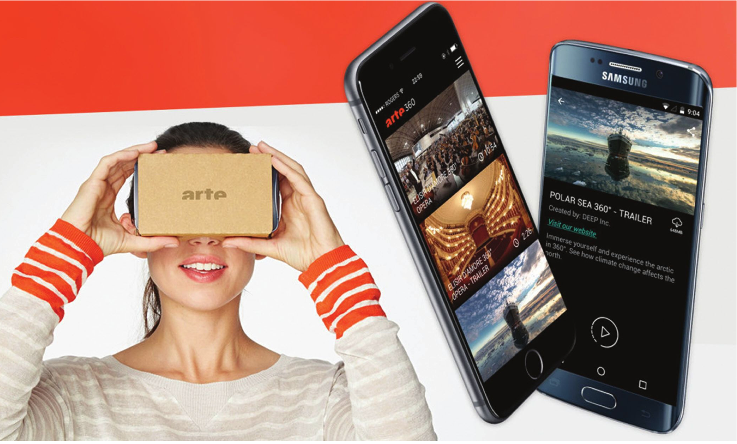Exclusives

M&E Journal: Virtual Reality Creates New Broadcast Opportunities
Story Highlights
By Nicole Greiner, Research Analyst, VAST Media
Virtual reality is gaining momentum. While some years ago, the technology still seemed futuristic and inaccessible to consumers, VR has come a long way and is starting to enter our living rooms. Thanks to a range of new and upcoming headsets, the technology is officially a trend, and no longer reserved for technology freaks and experts.
At the end of January, Google for the first time revealed some numbers around the adoption rate of its Cardboard, the low-cost DIY headset that turns nearly any phone into a VR viewer: since its introduction in 2014, 5 million of these devices have been shipped and users downloaded more than 25 million Google Cardboard apps from the company’s Play Store. Ten million of these downloads occurred between October and December 2015 alone, according to Google’s company blog, indicating a clearly growing interest in VR.
In the same timeframe, Samsung in November launched its $99 Gear VR powered by Oculus. The headset sold out on Amazon and Best Buy less than 24 hours after its release. 2016 promises to become a huge year for VR with both Oculus VR and HTC releasing the consumer editions of the Oculus Rift and HTC Vive Pre. The Oculus Rift, which costs $599, might have dampened the VR euphoria for some users as it is not exactly priced for the mainstream, but nevertheless the dawn of consumer VR is here and people are hungry for more.
For VR to really become a consumer product, however, the content ecosystem is key. We now have the devices (and their prices are expected to decline over the next months, as they usually do with new hardware), but there is still a lack of compelling content to make a broader consumer base want to purchase the more advanced headsets.
Gaming is discussed as the key driver for VR’s rise and the first industry to adopt the technology, but other industries engage in building VR experiences as well. Both Samsung and Oculus, for example, jumped into VR content production themselves and launched their own VR movie studios. But the TV might actually be the medium that will eventually let virtual reality break into the mainstream.
Numerous companies specializing in the production of VR content have emerged in the last couple of months. Startups and more established companies such as NextVR, Jaunt, Ovrture, IM360 and many more received millions of dollars of funding from media companies including Comcast, Time Warner, The Walt Disney Company and Sky. They assist broadcasters in developing new experiences for viewers that give a glimpse of what the future of television might look like.
At Vast Media, we are constantly on the lookout to provide our clients with case studies of unique and creative new projects in digital television and storytelling. In the last couple of months, we observed that the number of TV broadcasters and producers entering the bold new realm of virtual reality is beginning to spike. There are several ways in which VR could reshape television and the way we watch and interact with its content, as some early adopters in TV and their VR projects illustrate.
A 360-degree view of the world
In early December 2015, Franco-German culture channel ARTE launched its own dedicated virtual reality app and platform ‘ARTE360’ to provide viewers with easy access to all of its 360-degree productions. ‘ARTE360’ is available on the web, as an app and on the Samsung Gear VR. It was designed and developed in cooperation with DEEP Inc., a studio dedicated to exploring and defining the evolving language for cinematic storytelling in VR.
Users can immerse themselves in concerts, short films and documentaries – all shot using special 360-degree camera technology. The content can be explored from different perspectives by moving the mobile device or swiping the screen; users with a VR headset can switch to VR mode to take full advantage of the immersive videos. 360/VR storytelling is now a regular part of the channel’s content offering.
The films are either a complement to ARTE’s on-air programming or short stand-alone productions that transport the audience into space, deep down into the ocean or to operas.
Documentaries, nature films and concerts are all perfectly suited for experimenting with VR technology. As they usually aim to introduce the audience to an issue or world as vividly as possible, virtual reality is a useful and altogether different way of doing so.
In the future, actually traveling the world and exploring different places could to some extent be replaced by putting on a headset in the comfort of one’s own home.
News in VR gives the whole picture
 Pay-Tv operator Sky is also embracing the possibilities of virtual reality technology.
Pay-Tv operator Sky is also embracing the possibilities of virtual reality technology.
In mid-November, Sky News launched its first VR report titled Migrant Crisis – The Whole Picture, designed to give viewers a first person look at Europe’s migrant crisis.
The report from journalist Alistair Bucknall was made in collaboration with Jaunt, a pioneering virtual reality company in which Sky invested last year, and filmed using the new Jaunt ONE VR camera.
Bucknall provides commentary and shows users around different locations in Greece. That way, users get an impression of what it looks and feels like on a crowded beach where refugees just landed. He also takes viewers inside a tent where refugees reside. One way to watch the report is by downloading the Jaunt app and using a Cardboard headset. Users without a Cardboard can still experience the video in 360° on Sky News’ Facebook page or YouTube channel.
Virtual reality can make the news become more “real”, providing a whole new perspective on issues and events and giving a much deeper impression of what situations look like.
Closer to the action with live VR
FOX Sports, in partnership with live VR startup NextVR, hosted a live VR stream of several Premier Boxing Champions matches on January 23. The streams were available for free through the NextVR app for Samsung Gear VR headsets. Coinciding with the live broadcast on FOX Sports, Gear VR owners were able to virtually step inside the Staples Center in Los Angeles to experience three matches– Danny Garcia vs. Robert Guerrero, Sammy Vasquez Jr. vs. Aron Martinez and Amir Mansour vs. Dominic Breazeale- -closer than ever.
To realize the project, several cameras were set up inside the Staples Center, allowing viewers to follow the action right from the ring or from within the crowd. Additionally, graphics and fight commentary were integrated into the live stream.
 Live streams in virtual reality could not only become the norm for sports broadcasts, but also for other live events, as demonstrated by German broadcaster ProSieben, which streamed a season finale of The Voice in 360-degrees on the show’s website, and the 2015 MTV European Music Awards, which were fully available as a 360-degree live stream as well.
Live streams in virtual reality could not only become the norm for sports broadcasts, but also for other live events, as demonstrated by German broadcaster ProSieben, which streamed a season finale of The Voice in 360-degrees on the show’s website, and the 2015 MTV European Music Awards, which were fully available as a 360-degree live stream as well.
Through VR, live entertainment and sports on TV might be revolutionized as viewers can experience the events in a whole new way and get a sense of being there themselves.
Step into your favorite TV shows
In November, Fox’s horror comedy series Scream Queens released a “360 Closet Set Tour” of one of the character’s bedrooms on its Facebook page. The virtual set tour marked the beginning of “Scream Queens 360 VR,” an exclusive weekly VR experience that takes fans behind-the-scenes of the series and is also available on YouTube 360. The immersive videos are produced by VR production company SuperSphere.
The 360-degree set tours provide fans not only with a unique look behind the scenes of the show (e.g. the wardrobe trailer), but also let them step into the world of their favorite series as they can look around and explore the settings (e.g. the bedroom and closet of Chanel) from a new, inside perspective.
So, is VR the next big thing of the TV industry or will it face the fate of 3D television, which was also considered the future but failed to enter the mainstream? VR has made considerable progress in the past couple months, with more and more broadcasters jumping on the VR bandwagon and experimenting with the new storytelling opportunities the technology offers. It has by far not reached mainstream adoption yet, but over the next years, it could be the biggest game changer for how TV viewers consume content.
Click here to translate this article
Click here to download the complete .PDF version of this article
Click here to download the entire Spring 2016 M&E Journal









